Global Combined Heat Power Market Research, 2031
The global combined heat power market was valued at $24.6 billion in 2021, and is projected to reach $48.4 billion by 2031, growing at a CAGR of 7.2% from 2022 to 2031. The main factors driving the growth of the combined heat and power market are increasing government laws to support the use of CHP technology to reduce greenhouse gas emissions and expand knowledge about the advantages of energy efficient technology.
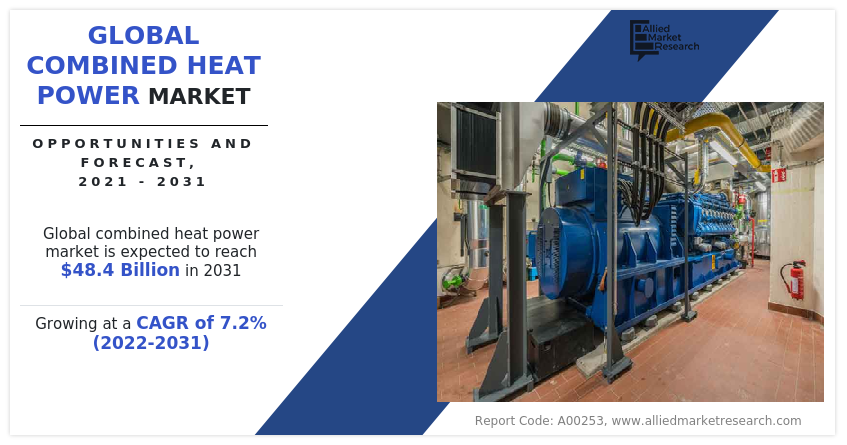
In addition, the economic and environmental benefits of the systems, as well as the reusability of the biproducts, are expected to increase demand for CHP systems, leading to the expansion of the installation market for these systems. The government regulations and large financial incentives for CHP systems are anticipated to boost demand for CHP installation. The growing popularity of natural gas as a cost-effective and environmentally friendly alternative to oil & coal are projected to contribute to combined heat power market growth.
One of the limitations to the development of the combined heat power market is lack of awareness about the site permissions necessary to install these systems. Installation of these systems is only appropriate for establishments that require both power and hot water, which acts as a barrier to market growth. Furthermore, the initial expenses of installing these combined heat and power systems are rather substantial, making them prohibitively expensive for small-scale enterprises.
The surge in usage of natural gas for power production and the increase in need for energy efficiency in industry are the primary drivers of the global combined heat power market. In addition, increased problems about greenhouse gases (GHG) emissions have led to the promotion of CHP by various governments, which has further boosted the growth of this industry. The growing innovative technologies and the expansion of distributed power generation are expected to boost the market. For instance, in February 2018, according to an update from the UK Government’s Department of Business, Energy, & Industrial Strategy, using cogeneration systems can minimize carbon emission by up to 30% compared to other conventional technologies.
The key players profiled in this report include MAN Diesel & Turbo SE, Caterpillar Inc., Mitsubishi heavy Industries ltd., General Electric, Cummins, Bosch Thermotechnology Ltd., ABB Limited, ENER-G Rudox, and Veolia.
The combined heat power market is segmented on the basis of fuel type, capacity, technology, application, and region. By fuel type, the market is divided into natural gas, coal, biomass, and others. By capacity, the market is classified into up to 10 MW, 10-150 MW, 151-300 MW, and above 300 MW. By technology, the market is categorized into combined cycle, steam turbine, gas turbine, reciprocating engine, and others. By application, the market is fragmented into commercial, residential, industrial, and utility. By region, the market is analyzed across North America, Europe, Asia-Pacific, and LAMEA.
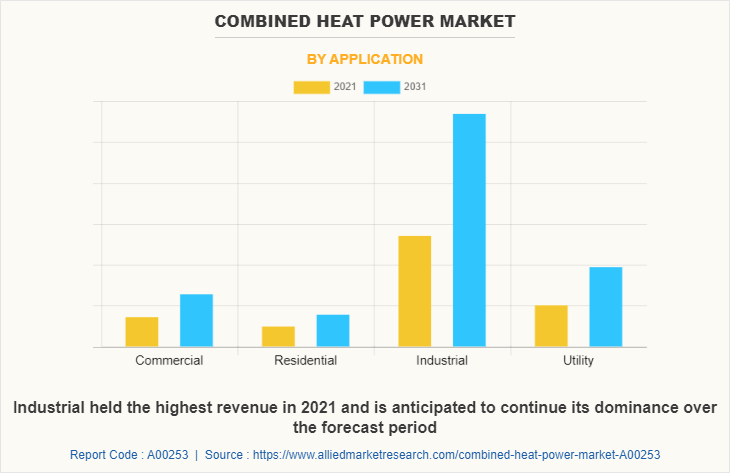
By application, the industrial cycle segment dominated the global combined heat power market share in 2021. The increase in use of combined heat and power systems in many sectors such as the petrochemical and pharmaceutical industries are anticipated to boost the market growth. In addition, encouragement of directives to increase combined heat and power installation across solar power units and growth of the residential and commercial sector supported by industrialization benefit the industrial segment. Owing to the rise in need for power, combined heat and power units are primarily used in industries.
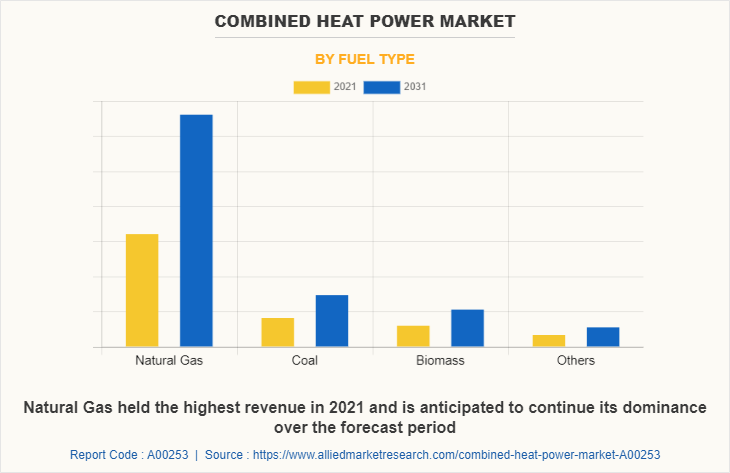
By fuel type, the natural gas segment dominated the market in 2021. Natural gas fueled combined heat and power systems dominated the entire market for the installation of Combined Heat and Power (CHP) systems. Owing to its low price and wide availability, natural gas is a useful fuel for combined heat and power systems. In addition, natural gas is recognized as a clean energy source that helps to lower carbon emissions. Owing to their high value and low cost, combined heat and power is expected to see an increase in demand as coal usage increases. Owing to its costly handling and emission of hazardous gases into the atmosphere, its use is limited. These are anticipated to be the major factors affecting the combined heat power market size during the forecast period.
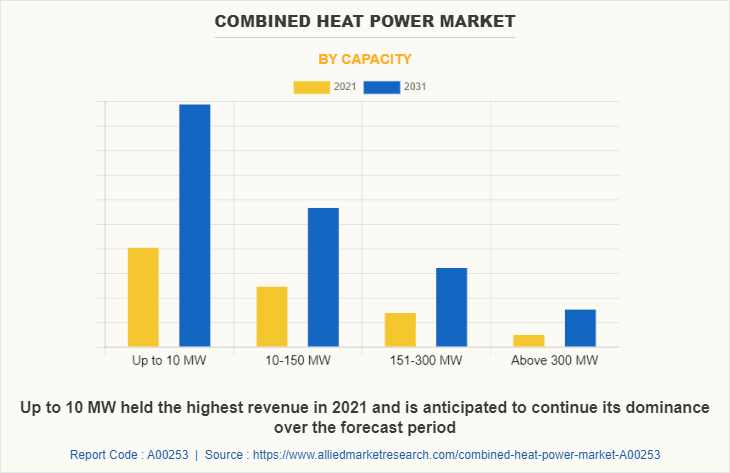
By capacity, the up to 10 MW segment dominated the global combined heat power market share in 2021. The residential combined heat and power systems typically range in size from 1.5kW to 0.5MW and operate on natural gas. Compared to other conventional systems, up to 10 MW aids in lowering energy expenses. In addition, the government's micro-CHP initiative for fuel cells powers up to 10 MW. Fuel cells produce electricity without burning fuel, in contrast to reciprocating engines and gas turbines. For instance, cogeneration solutions in this power range are commonly provided by AB Holding, 2G Energy, FuelCell Energy, and Capstone.
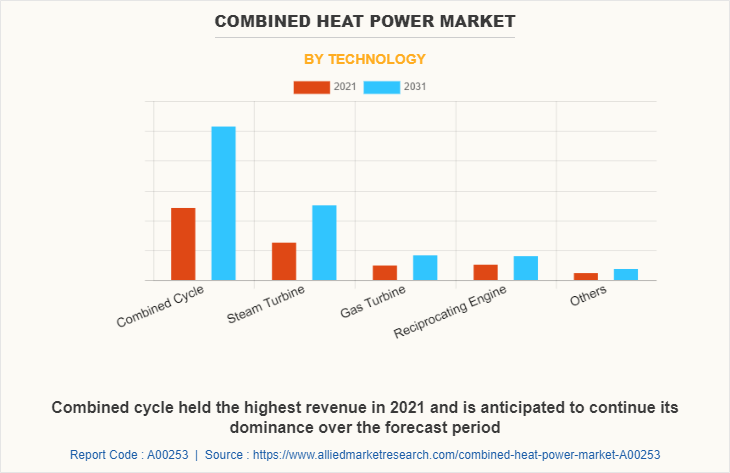
By technology, the combined cycle segment dominated the global combined heat power market share in 2021. These systems are typically used in industries with high energy demands, such as chemicals, refining, cement, pulp, paper, sugar, and medicines. When compared to other technologies, non-fuel operation, cheap installation & maintenance costs, low pollution, start-up time, fuel availability, heat output, and energy efficiency are all significant advantages.
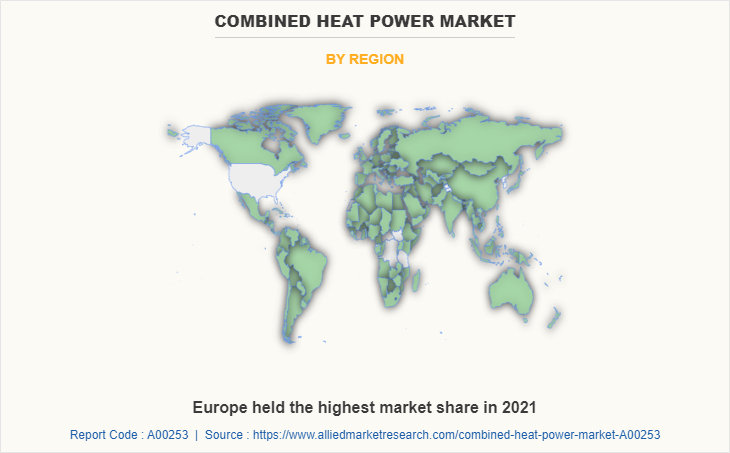
By region, Asia-Pacific is anticipated to be the fastest-growing segment during the forecast period. The fast industrialization and urbanization, as well as rising market demand for clean fuel energy, which boost market growth in the region, have resulted in the development of new combined heat and power in emerging economies. For instance, Bert Energy GmbH revealed its Bert Mobil Gas demo plan, which commissioned at Sri City, Andhra Pradesh, India. In addition, natural gas supply & price outlook, improved energy efficiency, and environmental restrictions for industrial boilers & power plants are anticipated to encourage the installation of cogeneration systems throughout the region.
Impact of COVID-19 on the Global Combined Heat Power Industry
COVID-19 negatively impacted various industries such as energy and power that led to a drastic decline in energy and power industry sales. As combined heat and power is widely used in power and energy manufacturing, there was significant reduction in the combined heat and power demand globally.
China is the leading producer and exporter of raw materials such as feedstock required for combined heat and power production. However, China being the epicenter of the coronavirus pandemic, its export was affected, leading to a decline in combined heat and power energy.
Economic slowdown affected the setup of new combined heat and power projects across the world as majority of government fundings were diverted toward healthcare sector owing to rapid spread of the COVID-19 virus, impacting the market to a great extent.
Key Benefits For Stakeholders
- This report provides a quantitative analysis of the market segments, current trends, estimations, and dynamics of the global combined heat power market analysis from 2021 to 2031 to identify the prevailing global combined heat power market opportunities.
- The market research is offered along with information related to key drivers, restraints, and opportunities.
- Porter's five forces analysis highlights the potency of buyers and suppliers to enable stakeholders make profit-oriented business decisions and strengthen their supplier-buyer network.
- In-depth analysis of the global combined heat power market segmentation assists to determine the prevailing market opportunities.
- Major countries in each region are mapped according to their revenue contribution to the global combined heat power market forecast.
- Market player positioning facilitates benchmarking and provides a clear understanding of the present position of the market players.
- The report includes the analysis of the regional as well as global combined heat power market trends, key players, market segments, application areas, and market growth strategies.
Combined Heat Power Market Report Highlights
| Aspects | Details |
| Market Size By 2031 | USD 48.4 billion |
| Growth Rate | CAGR of 7.2% |
| Forecast period | 2021 - 2031 |
| Report Pages | 280 |
| By Technology |
|
| By Application |
|
| By Fuel Type |
|
| By Capacity |
|
| By Region |
|
| Key Market Players | 2G Energy AG, Simens AG, Veolia, Mitsubishi Electric Corporation, FuelCell Energy, Inc., Tecogen Inc, Bosch Ltd, General Electric, Wartsila, bdr thermea |
Analyst Review
Rapid industrialization in developed & developing countries, surge in manufacturing processes & production units trying to fulfil ongoing product demand, and high government spending on current infrastructure related to electricity generation are some of the major factors expected to drive the global combined heat power market. However, the government is focusing on creating alternative sources of electricity generation as there are high costs associated with producing electricity. The development in the energy industry and rise in demand on reliable energy have promoted the use of combined heat and power systems, which in turn drive the market growth. The market development is expected to be boosted by a drive toward replacing conventional energy systems owing to significantly reduced operating costs and reliable utility supply. The surge in demand for energy in the international market is one of the main factors driving the combined heat and power market growth.
Among the analyzed regions, Europe is expected to account for the highest revenue in the market by the end of 2031, followed by Asia-Pacific, North America, and LAMEA. Rapid industrialization and urbanization are the key factors responsible for leading position of Europe and Asia-Pacific in the global combined heat power market.
The demand for combined heat and power systems products has increased globally due to rising environmental awareness and emphasis on energy waste. In addition, adoption of natural gas and future developments in solar combined heat power are expected to open new opportunities for market across key industries, creating tremendous potential in the combined heat power industry.
The major growth strategies adopted by combined heat power market players are investment and agreement.
The report provides an extensive qualitative & quantitative analysis of the current trends and future estimations of the global combined heat power market from 2021 to 2031 to determine the prevailing opportunities.
Energy and power segment of the end-use industry acquired the maximum share of the global combined heat power market in 2021.
Great state incentives, strong measures, methods, and CHP-compliant environmental laws are among the main drivers promoting economic sector development facilities, which are expected to boost the combined?heat power market in the next few years.
Asia-Pacific is expected to provide more business opportunities for the global combined heat power market in future.
MAN Diesel & Turbo SE, Caterpillar Inc., Mitsubishi heavy Industries ltd., General Electric, Cummins, Bosch Thermotechnology Ltd., ABB Limited, ENER-G Rudox, and Veolia are the major players in the combined heat power market.
Loading Table Of Content...


